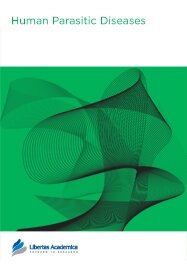

Publication Date: 24 Mar 2011
Type: Hypothesis
Journal: Human Parasitic Diseases
Citation: Human Parasitic Diseases 2011:3 1-10
doi: 10.4137/HPD.S5601

Trichomonas vaginalis is a parasitic protozoan causing the most common human sexually transmitted disease (STD), trichomoniasis. The exact mechanism of its pathogenesis is still obscure. Alpha-enolase plays a pivotal role in the host-pathogen interaction, and as a surface receptor of several protists mediating plasminogen binding. In view of identifying plasminogen binding sites of T. vaginalis alpha-enolase, homology modeling and docking studies were conducted to obtain modeled structures of the T. vaginalis alpha-enolase-plasminogen complex. Modeling templates were searched by using BLAST, followed by multiple sequence alignment. The atomic coordinates of Escherichia coli enolase was retrieved from Protein Data Bank. Molecular structures of T. vaginalis alpha-enolase were modeled by using restraint-based modeling, followed by energy minimization using MODELLER program. The quality and stereochemistry of the models were evaluated by program PROCHECK. After addition of Mg2+, the selected model further refined by energy minimization employing NAMD program. The VMD program was used to superimpose structure of T. vaginalis alpha-enolase model with crystal structures of enolases from E. coli and S. pneumoniae. T. vaginalis alpha-enolase model was docked to human plasminogen for protein-protein interaction using Hex 5.1. Mark Gerstein’s calc-surface program was used to calculate the solvent accessibility at the interface of T. vaginalis alpha-enolase and human plasminogen before and after docking. The finding provides new insights for interaction at the protein-protein interface. Our theoretical prediction is consistent with preexisting biochemical data. The predicted interaction complex can be of great assistance in understanding structural insights, probably being necessary to an interaction between pathogen and host-component. The ability of T. vaginalis alpha-enolase to bind plasminogen may be indicative of being a key player in invasion of this pathogen to host. Conclusively, this work theoretically establishes the T. vaginalis alpha-enolase as a novel surface-linked virulence factor.
PDF (3.60 MB PDF FORMAT)
RIS citation (ENDNOTE, REFERENCE MANAGER, PROCITE, REFWORKS)
BibTex citation (BIBDESK, LATEX)

My experience publishing in Human Parasitic Diseases was very positive. I was very satisfied with the rapid and high-quality review process and the constructive feedback. The comments from the reviewers allowed me to improve the paper significantly. I highly recommend that other researchers publish their papers in Libertas Academia Journals.
Facebook Google+ Twitter
Pinterest Tumblr YouTube